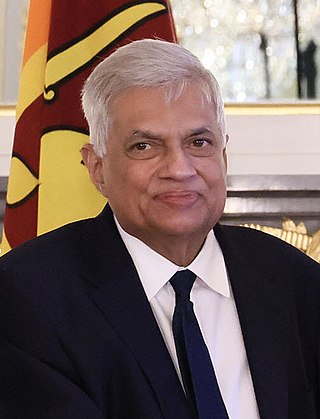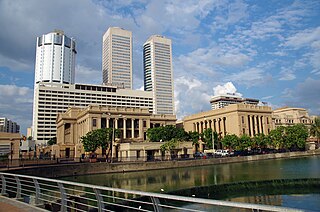Sri Lanka is a semi-presidential representative democratic republic, whereby the President of Sri Lanka is both head of state and head of government, and it relies on a multi-party system. Executive power is exercised by the President on the advice of the Prime Minister and the Cabinet of Ministers. Legislative power is vested in the Parliament. For decades, the party system was dominated by the socialist Sri Lanka Freedom Party and the conservative United National Party. The Judiciary is independent of the executive and the legislature.

The president of Sri Lanka is the head of state and head of government of the Democratic Socialist Republic of Sri Lanka. The president is the chief executive of the union government and the commander-in-chief of the Sri Lanka Armed Forces.

Ranil Wickremesinghe is a Sri Lankan politician who is the 9th and current President of Sri Lanka. He also holds several ministerial positions, including the Minister of Finance, Minister of Defence, Minister of Technology and Minister of Women, Child Affairs and Social Empowerment.

The United National Party is a centre-right political party in Sri Lanka. The UNP has served as the country's ruling party, or as part of its governing coalition, for 38 of the country's 74 years of independence, including the periods 1947–1956, 1965–1970, 1977–1994, 2001–2004 and 2015–2019. The party also controlled the executive presidency from its formation in 1978 until 1994 and back in 2022.

Mahinda Rajapaksa is a Sri Lankan politician. He served as the President of Sri Lanka from 2005 to 2015; the Prime Minister of Sri Lanka from 2004 to 2005, 2018, and 2019 to 2022; the Leader of the Opposition from 2002 to 2004 and 2018 to 2019, and the Minister of Finance from 2005 to 2015 and 2019 to 2021. He has been a Member of Parliament (MP) for Kurunegala since 2015.

William Gopallawa was the last Governor-General of Ceylon from 1962 to 1972 and the first and only non-executive President of Sri Lanka from 1972 to 1978, when Ceylon declared itself a republic and changed its name to Sri Lanka.

The governor-general of Ceylon was the representative of the Ceylonese monarch in the Dominion of Ceylon from the country's independence in 1948 until it became the republic of Sri Lanka in 1972.

Nandasena Gotabaya Rajapaksa, is a former Sri Lankan politician and military officer, who served as the eighth President of Sri Lanka from 18 November 2019 until his resignation on 14 July 2022 due to months of public anger. He previously served as Secretary to the Ministry of Defence and Urban Development from 2005 to 2015 under the administration of his elder brother former President Mahinda Rajapaksa, during the final phase of the Sri Lankan Civil War.
Temple Trees is the official residence of the Prime Minister of Sri Lanka. It is located in Colombo, Sri Lanka. Several recent Presidents have used it as their official residence as well.

Lasantha Manilal Wickrematunge was a high-profile Sri Lankan journalist, politician, broadcaster and human rights activist who was assassinated in January 2009.

Fort (Colombo) (කොටුව; கோட்டை) is the central business district of Colombo in Sri Lanka. It is the financial district of Colombo and the location of the Colombo Stock Exchange (CSE) and the World Trade Centre of Colombo from which the CSE operates. It is also the location of the Bank of Ceylon headquarters. Along the foreshore of the Fort area is the Galle Face Green Promenade, built in 1859 under the governance of Sir Henry George Ward, the Governor of Ceylon (Sri Lanka) during British colonial era. Fort is also home to the General Post Office, hotels, government departments and offices.

The Nelum Pokuna Theatre is a performing arts centre in Colombo, Sri Lanka. The theatre opened on 15 December 2011.

The Prime Minister of the Democratic Socialist Republic of Sri Lanka is the head and most senior member of parliament in the cabinet of ministers. It is the second-most powerful position in Sri Lanka's executive branch behind the president, who is the constitutional chief executive. The Cabinet is collectively held accountable to parliament for their policies and actions.

First Lady of Sri Lanka refers to the wife of the President of Sri Lanka. To date, there have been eight women who have served in the role. The current First Lady of Sri Lanka is Professor Maithree Wickremesinghe, wife of President Ranil Wickremasinghe, who has held the position since 20 July 2022. There have been no first gentlemen of Sri Lanka to date, since former President Chandrika Kumaratunga, the country's only female head of state, was a widow while in office.

The Sri Lanka People's Front, commonly known by its Sinhalese name Sri Lanka Podujana Peramuna (SLPP), is a political party in Sri Lanka. Previously a minor political party known as the Sri Lanka National Front (SLNF) and Our Sri Lanka Freedom Front (OSLFF), it was relaunched in 2016 as the SLPP and became the home for members of the United People's Freedom Alliance loyal to its former leader Mahinda Rajapaksa.

Mohamed Uvais Mohamed Ali Sabry, PC, MP, also known as Ali Sabry, is a Sri Lankan lawyer and politician. He is the Current Minister of Foreign Affairs serving since 22 July 2022. He previously served as the Minister of Finance until 9 May 2022. He was a Member of Parliament, appointed from the national list of the Sri Lanka Podujana Peramuna. He also served as the Minister of Justice until 9 May 2022. He served as the defense counsel of President Gotabaya Rajapaksa, chief legal adviser and President of the Muslim Federation of the Sri Lanka Podujana Peramuna.
The following lists notable events that took place during the year 2022 in Sri Lanka.

The 2022 Sri Lankan protests, commonly known as Aragalaya, were a series of mass protests that began in March 2022 against the government of Sri Lanka. The government was heavily criticized for mismanaging the Sri Lankan economy, which led to a subsequent economic crisis involving severe inflation, daily blackouts, and a shortage of fuel, domestic gas, and other essential goods. The protesters' main demand was the resignation of President Gotabaya Rajapaksa and key officials from the Rajapaksa family. Despite the involvement of several opposition parties, most protesters considered themselves to be apolitical, with many expressing discontent with the parliamentary opposition. Protesters chanted slogans such as "Go Home Gota", "Go Home Rajapaksas", and "Aragalayata Jaya Wewa". Most protests were organized by the general public, with youths playing a major part by carrying out protests at Galle Face Green.
The New Lanka Freedom Party is a political party in Sri Lanka which was founded by ex-SLFP politician Kumara Welgama in 2020. The party is known for its close ties with former president of Sri Lanka and former leader of the SLFP Chandrika Kumaratunga, who, like Welgama, has been a vocal critic of former president Gotabaya Rajapaksa.















